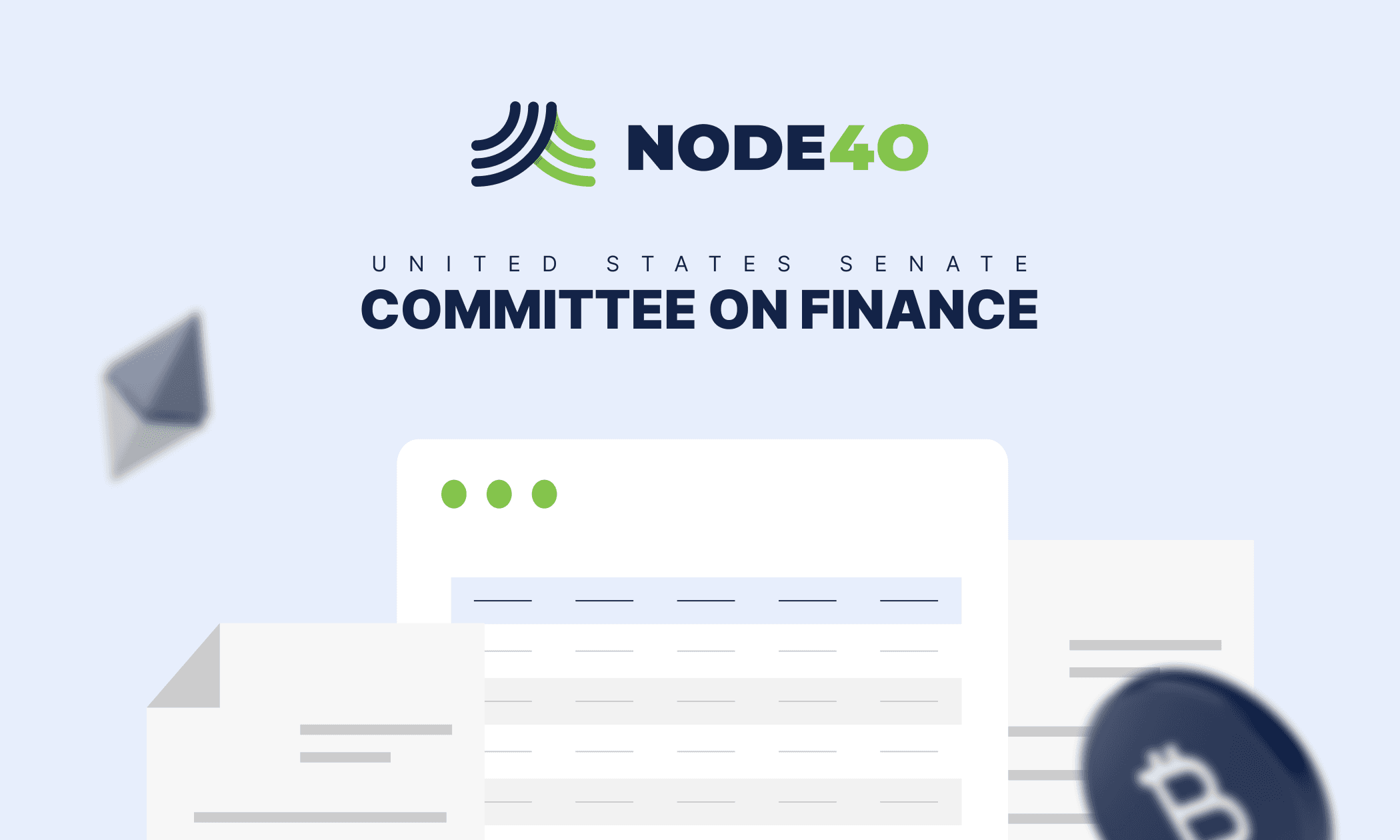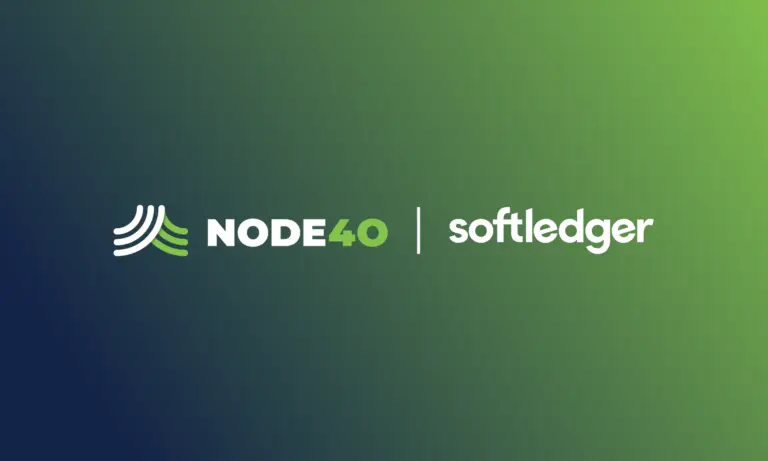NODE40’s Responses to a Request for Feedback from Senate Finance Committee Chairman Ron Wyden and Finance Committee Ranking Member Mike Crapo on the tax challenges and opportunities presented by digital assets
Dear Chairman Wyden and Ranking Member Crapo,
NODE40 Inc. is a company based in Albany, NY that specializes in the economic analysis and financial reporting for digital asset activity. We provide multiple perspectives of this activity without taking positions on the appropriateness of the accounting treatment, taxation and regulatory compliance. NODE40’s data solutions are used primarily by public accounting firms, fund administrators, and other financial entities. We prioritize raw data analytics that are converted into valuable, actionable information. Our solution aggregates off-chain data (e.g., from a centralized exchange (“CEX”)) and on-chain data from available sources to trace the entire lifecycle of digital assets, from cost basis to disposition to other profit and loss events. We also contextualize (i.e, provide a financial story) for transactions by processing critical data and metadata for decentralized finance (“DeFi”) and non-fungible token (“NFT”) transactions. This includes normalizing account categories for deposits, yield-farming, lending, collateralization, minting, swapping, dispositions and other categories of transactions. (All “section” references herein are references to the Internal Revenue Code of 1986, as amended (the “Code”).)
Given our specialization in preparing digital asset financial data for multiple purposes including tax compliance, we focus below on certain compliance challenges addressed by the Senate Finance Committee (the “Committee”). The Committee asked several questions that could arise if section 1058 expressly applied to digital assets. Among other questions, the Committee specifically asked whether companies that allow customers to lend digital assets would institute a standard loan agreement to comply with the requirements of section 1058, and, if so, what challenges would compliance present. The Committee also asked several other questions including an inquiry about how to treat a hard fork, protocol change, or airdrop during the term of a loan.
Background on Current Code Section 1058
Section 1058 currently applies a safe harbor for nonrecognition of gain or loss on certain securities lending transactions that meet various requirements. In adding section 1058 to the Code, Congress intended to provide nonrecognition treatment to securities loans in which “the contractual obligation [to return identical securities] does not differ materially either in kind or in extent from the securities exchanged . . . .” S. Rep. No. 762, 95th Cong., 2d Sess. 7 (1978); 1978-2 C.B. 357, 361 (“Senate Report”). The legislative history further states that:
“[b]ecause of time delays which a broker may face in obtaining securities (from a seller or transfer agent) to deliver to a purchaser, brokers are frequently required to borrow securities from organizations and individuals with investment portfolios for use in completing these market transactions. It is generally thought to be desirable to encourage organizations and individuals with securities holdings to make the securities available for such loans since the greater the volume of securities available for loan the less frequently will brokers fail to deliver a security to a purchaser within the time required by the relevant market rules.” Senate Report at 3.
Section 1058(a) provides that in the case of a taxpayer who transfers securities pursuant to an agreement which meets the requirements of section 1058(b), no gain or loss shall be recognized on the exchange of such securities by the taxpayer for an obligation under such agreement, or on the exchange of rights under such agreement by that taxpayer for securities identical to the securities transferred by that taxpayer. Section 1058 cross-references to section 1236(c) for the definition of “securities”. Currently that definition does not specifically reference digital assets.
Section 1058(b) provides that, in order for a securities loan agreement to meet the requirements of section 1058, the agreement must meet the following conditions:
- The agreement must “provide for the return to the transferor of securities identical to the securities transferred”; [Section 1058(b)(1)]
- The agreement must “require that payments shall be made to the transferor of amounts equivalent to all interest, dividends, and other distributions which the owner of the securities is entitled to receive during the period beginning with the transfer of the securities by the transferor and ending with the transfer of the identical securities back to the transferor;” (Such amounts are generally referred to here as “substitute payments”); [Section 1058(b)(2)]
- The agreement must “not reduce the risk of loss or opportunity for gain of the transferor of the securities in the securities transferred”; [Section 1058(b)(3)] and
- The agreement must “meet such other requirements as [the U.S. Treasury] may by regulation prescribe.” [Section 1058(b)(4)]
In legislative history, Congress stated that such “other requirements” proscribed by the U.S Treasury are “not to include requirements which are inconsistent with normal commercial practice, as permitted by the Securities and Exchange Commission, as of the date of enactment of this provision.” Senate Report, at 7. The U.S. Treasury and Internal Revenue Service issued proposed regulations under section 1058 in 1983; however, those regulations have yet to be finalized. Among other requirements, Proposed Regulation 1.1058-1(b) states that the lending agreement must be in writing.
Compliance Issues Regarding Application of Section 1058 to Digital Assets
Lending of digital assets may present various issues that are not present for loans of traditional stock or securities. In particular, the data tracking requirements for digital assets present a host of challenges as described below.
- Currently, unlike for traditional securities, there is no “normal commercial practice” set out by any regulatory body prescribing how parties are to prepare a digital asset lending agreement, including, in particular, for cryptocurrencies, NFTs, stablecoins and other digital assets. Nor are there any industry standards for such agreements as there is in the securities lending industry. (Notably, the International Securities Lending Association (ISLA), an industry association representing securities lending and financing market participants across Europe, Middle East and Africa, in conjunction with Ashurst, issued a whitepaper, Preparing the Global Master Securities Lending Agreement (GMSLA) for an Evolving Digital Asset Landscape’ (November 2022) See the following: https://www.islaemea.org/news/isla-publishes-joint-paper-on-gmsla-for-an-evolving-digital-asset-landscape/). Some corporate (or LLC) entities engaged in digital asset lending have prepared actual agreements. Other digital asset lending arrangements may take place within a so-called “smart contract” such as for a DeFI protocol. (Although a smart contract may encompass some terms of an agreement, a smart contract’s terms are executed as code running on a blockchain like Ethereum.) Although a DeFi protocol may have manual user documents, there may not be a traditional written loan agreement between the parties. Consideration should be given as to how the U.S. Treasury will write rules that enable taxpayers to verify compliance with any requirement that a digital asset lending take place under the terms of an agreement, including, circumstances where there is no formal written agreement in the traditional sense.
- Taxpayers may be involved in lending digital assets both on Centralized Exchanges (known as CEXs) and on decentralized exchanges (known as DEXs). For CEXs, it would be important for the U.S. Treasury to take into account compliance requirements for taxpayers to programmatically access digital asset loan details and data from CEXs. In particular, for DEXs, key issues will be the analysis of data and metadata from smart contracts which may or may not constitute “loan agreements” depending on the protocol.
- For traditional securities, “substitute payments” are generally in the form of dividends or interest. However, for many types of digital assets, such as cryptocurrencies, Congress may (or may not) decide that substitute payments include a hard fork, protocol change, or airdrop during the term of the loan. The Committee asked about how such events should be taxed if section 1058 applies to digital assets. Questions also arise regarding the treatment of a hard fork, protocol change, or airdrop on collateral, if any, supporting the loan. Regardless of how Congress decides to treat such events from a U.S. federal income tax standpoint under section 1058 (or similar Code provision), consideration should be given to how the U.S. Treasury and taxpayers will handle tracking the data regarding a hard fork, protocol change, airdrop or similar event to confirm compliance with any new Code provisions. Such tracking will also impact the ability of taxpayers to efficiently comply with federal tax return requirements. Further, any challenges involving data tracking may be different for centralized exchanges as compared to other protocols such as decentralized exchanges.
We very much appreciate your request for comments from the tax and digital asset communities to provide clarity and guidance for the future of the industry.



